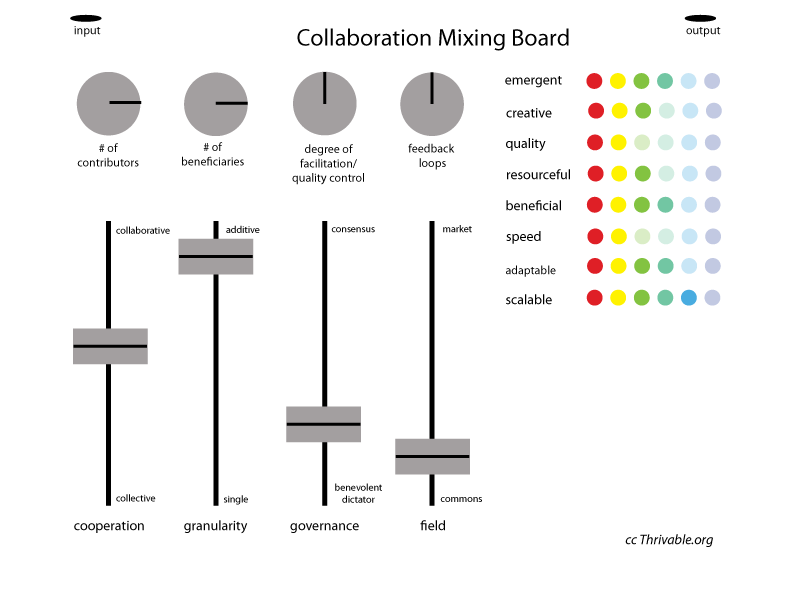This morning I read a RT from @jhagel:
Open source trumps crowdsource – by @cdgramshttp://bit.ly/bIn1at
And an idea that has been bubbling in the back of my head came to the surface begging to be set free. Collaboration and Cooperation are complex processes. Setting up them as rivals diminishes the value each provide us. One is not better than another as much as one may be more or less appropriate for a particular issue. And there are a bunch of knobs and dials to adjust based on what we have to put into the system and what we would like to have as output.
My initial “Mixing Board” points to several of these knobs and dials and some of the measures we might watch. I hope you will consider these and contribute to a revised version that holds greater rigor and collective wisdom. ![]() Collaborate with me!
Collaborate with me!
 This is the basic mixer. We have 3 areas: the Dials – things that feel measurable and adjustable, the Knobs – things that feel like a spectrum, and the Lights – things that we can sense but probably not directly adjust.
This is the basic mixer. We have 3 areas: the Dials – things that feel measurable and adjustable, the Knobs – things that feel like a spectrum, and the Lights – things that we can sense but probably not directly adjust.
The Dials:
- # of contributors (5 people, 25, 100, 1000, 10000, etc)
- # of beneficiaries (5 people, 25, 100, 1000, 10000, etc)
- degree of facilitation/quality control (none, light-handed, moderated, tight, regulated)
- none – for example – the ability to co-create the internet approaches NO facilitation and NO quality control.
- light-handed – co-creating youtube is light-handed (as is most major social media space) with very simple rules.. and very little quality control
- moderated – wikipedia has a process for including content, a system for elevating reputation, and a fairly advanced peer produced quality control system and standards
- tight – most blogs (from harvard business blogs to Daily Kos) where several people have permission to add posts (the comment option might be handled lightly to not at all however) and the quality control is high (even if the quality is not high – the control of it is)
- regulated – let’s talk wall street stats or sports numbers collecting on websites – there is regulation about the information to control the quality and the facilitation is more in the realm of bureaucracy
- feedback loops – do stakeholders/creators have ways of getting feedback on the collaborations? For example, couchsurfing ratings. I presume that collaborations in which people know they are successful via tight feedback loops encourage more collaboration. This is simply my assumption.
![:)]()
Then we have The Knobs or Spectrums:
- cooperation – from collective to collaborative (to what degree are people creating/generating through interaction with each other? Is it the number who show up or the output of their engagement with each other? CarrotMobs are about the number (collective) and team sports are about the combined output and interaction (collaborative).
- granularity – from single output to many outputs that can be added together. A single output could be a logo design or a designed t-shirt… where an additive output is something like Linux – composed of hundreds or even thousands of pieces where individual authorship of the granule still allows for collective production of a larger work.
- governance – from benevolent dictator to consensus, who manages the collaboration? An individual, a leadership circle, a revolving/evolving group, or full consensus of all involved, etc.
- field – from commons to market – what does the output create in total? Does it create a market for individuals to succeed (or fail) within or a commons for all to share?
Finally we have The Lights – given the settings of the Knobs and Dials, what can we sense?
- emergent – does the collaboration create the conditions for emergence? To what degree?
- creative – does the collaboration enable creative effort or stifle it?
- quality – does the collaboration produce high quality results/outputs? (by whose definition?)
- resourceful – does it optimally engage the resources of those collaborating?
- beneficial – does it create benefits? (one could ask for who?)
- speed – how long does the collaboration take?
- adaptable – how able is the collaboration to make adjustments in response to the environtment
- scalable – can the collaboration expand? to what degree? (not that scaling is always ideal! it isn’t!)





















